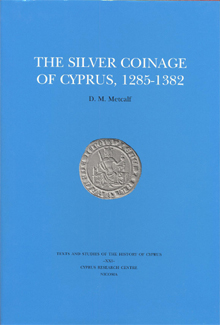Description
During the reign of Henry II (1285-1324) a new, large silver coin, inspired by the French gros tournois, was introduced in Cyprus, and became the standard currency of the island, replacing the white bezants. The silver gros was worth half a bezant (henceforward merely the name of a money of account), or 24 deniers. Its half, the gros petit, was worth 12 deniers. This volume is the first to appear, but the second in order, of a projected three-volume corpus of the coinage of Cyprus in the Lusignan period, under the editorship of Andreas Pitsillides, the President of the Cyprus Numismatic Society, and Michael Metcalf, of the Ashmolean Museum, Oxford. Based on a prolonged study of about 3500 speciments world-wide, volume 2 records every known obverse die, and is the definitive work. Anyone who wishes to identify a gros or gros petit of the reigns of henry II, Amaury, Hugh IV, Peer I, or Peter II has a 95 per cent chance of matching the self-same obverse die, in the 48 high-quality plates on which over 700 chosen specimens are illustrated, in sylloge style. The survival-rate of the fourteenth-century coinage has been exceptionally high, because Genoese hostilities in the 1470s caused the concealment and non-recovery of many coin hoards. The 100-page text gives a very detailed analysis of the dies, and cumulatively offers proof that there were not one but two major mints in fourteenth-century Cyprus, at Nicosia and Famagusta. The argument is that the patterns created by the stylistic similarities of the dies, and by die-links, demonstrate two distinct and coherentsequencesfor each reign, which cannot plausibly be placed end-to-end, or even side by side in two workshops of a single mint. There is documentary confirmation of a mint at Famagusta from the trading account of a Barcelona merchant. It seems that there was occasionally a third mint, perhaps at Limassol. Pegolotti’s Practica della mercatura reveals that the mint was sometimes in the king’s hands, and sometimes farmed. This is probably the explanation for the field-marks found on some of the coins.





